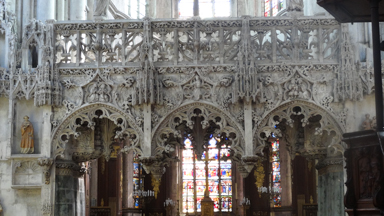Ramble - Troyes
Okay, let’s start with the pronunciation of the city of Troyes. One would, at first glance, think it was pronounced as we pronounce “Troy” in English; I mean, after all, there are only two lousy letters tacked on to the end, and everyone knows that in French, you don’t pronounce the ‘s’ at the end of a word, and the ‘e’ only serves to force the pronunciation of the letter before it, so it’s “troy,” right.
Well, no. This is French, remember? So here’s a little help. The French word for the number three is trois and is pronounced “twa.” Totally ignore that you think maybe it would be a good idea to actually pronounce the ‘r’ in the middle or the ‘s’ at the end, and that ‘oi’ might be pronounced like it looks. Anyway, now that you know how to pronounce trois, you also know how to pronounce Troyes because, although trois and Troyes don’t look a lot alike, they are pronounced exactly the same. Yep, exactly the same. Crazy language.
But I digress… Troyes is an interesting city. It’s big - population of some 65,000 plus probably an equal number in the area. In terms of famous people, not so interesting, though Pope Urban IV (Pope from 1261 to 1264) was born here. Joan of Arc and Charles VII freed the city from the English in 1429.
Troyes’ claim to fame is that, for some reason, the city has maintained hundreds of half-timbered buildings in the downtown area since the 16th century. Recently, the city has revamped that downtown area to remove automobiles and leave the area to pedestrians; as a result, many restaurants and bars and stores have thrived here. I will post below some pictures of the streets and buildings of Troyes; during the day - and especially on a hot Friday evening - these are jammed with folks. If you want to see them without the crowds, be there at 7:30 in the morning…
Troyes Buildings











Streets





Iglise St. Madeline
I wanted to see this church because my guidebook said it has one of the few remaining “rood screens” in France. The rood screen - jubé in French - was a partition between the nave, where the parishioners sat for a Mass, and the choir, where the priests conducted the Mass. This jubé, besides being one of the last, is one of the most ornate - an example of Flamboyant Gothic sculpture.

The jubé was, indeed, worth seeing, but better were the stained-glass windows. Created in the 16th century, they are beautiful and unusual in two respects: they have been recently restored; and they are down low, so a person can see them quite clearly. In many churches, the stained-glass is so high in the walls that it’s difficult to see the details.


We liked Troyes, though it’s not high on our “return-to” list. We wouldn’t make a special trip back here, but if we were in the area, we’d return, if for no other reason that to see those windows again.